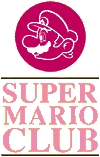Mario Club: Difference between revisions
m TheFlameChomp moved page Mario Club on wheels to Mario Club over redirect |
mNo edit summary |
||
| Line 1: | Line 1: | ||
''Not to be confused with the Japanese TV program, [[mariowiki:Super Mario Club (television series)|Super Mario Club]] that broadcast from 1990 to 1993.'' | ''Not to be confused with the Japanese TV program, [[mariowiki:Super Mario Club (television series)|Super Mario Club]] that broadcast from 1990 to 1993.'' | ||
[[File:Mario Club logo.png|frame|right|The current Mario Club logo]] | [[File:Mario Club logo.png|frame|right|The current Mario Club logo]] | ||
'''Mario Club Co. Ltd''' (Japanese: マリオクラブ株式会社) is a Japanese subsidiary of [[Nintendo]] that plays tests video games and works on debugging them with the aim of delivering high-quality products | '''Mario Club Co. Ltd''' (Japanese: マリオクラブ株式会社) is a Japanese subsidiary of [[Nintendo]] that plays tests video games and works on debugging them with the aim of delivering high-quality products<ref>[http://www.marioclub.co.jp/ Official Mario Club website - "お客様に高品質な製品をお届けすること。それが私たちの使命です。"]</ref>. It is named after Nintendo's famous mascot [[Mario]] and employs part-time workers. | ||
Mario Club spun off from the quality control department within Nintendo in which Kenji Saiki (Japanese: 斎木健次) acted as business chief, named '''Super Mario Club''' (Japanese: スーパーマリオクラブ) or '''Mario Club''' (Japanese: マリオクラブ)<ref>[http://www.nintendo.co.jp/nom/0004/04/page01.html Nintendo Online Magazine (April 2000) interview (in Japanese)]</ref> to become its own subsidiary in July 2009.<ref>[http://www.inside-games.jp/article/2009/09/16/37696.html Nihon Keizai Shinbun (日本経済新聞) via 任天堂、品質管理部門を分社化―マリオクラブ株式会社を設立 (September 16th 2009) - INSIDE-GAMES (in Japanese).]</ref> | Mario Club spun off from the quality control department within Nintendo in which Kenji Saiki (Japanese: 斎木健次) acted as business chief, named '''Super Mario Club''' (Japanese: スーパーマリオクラブ) or '''Mario Club''' (Japanese: マリオクラブ)<ref>[http://www.nintendo.co.jp/nom/0004/04/page01.html Nintendo Online Magazine (April 2000) interview (in Japanese)]</ref> to become its own subsidiary in July 2009.<ref>[http://www.inside-games.jp/article/2009/09/16/37696.html Nihon Keizai Shinbun (日本経済新聞) via 任天堂、品質管理部門を分社化―マリオクラブ株式会社を設立 (September 16th 2009) - INSIDE-GAMES (in Japanese).]</ref> | ||
Revision as of 23:58, 23 April 2022
Not to be confused with the Japanese TV program, Super Mario Club that broadcast from 1990 to 1993.

Mario Club Co. Ltd (Japanese: マリオクラブ株式会社) is a Japanese subsidiary of Nintendo that plays tests video games and works on debugging them with the aim of delivering high-quality products[1]. It is named after Nintendo's famous mascot Mario and employs part-time workers.
Mario Club spun off from the quality control department within Nintendo in which Kenji Saiki (Japanese: 斎木健次) acted as business chief, named Super Mario Club (Japanese: スーパーマリオクラブ) or Mario Club (Japanese: マリオクラブ)[2] to become its own subsidiary in July 2009.[3]
The current managing director is Yuichi Kitamaru (Japanese: 北村 裕一).[4] Formally, the managing director was Kaoru Takemura (Japanese: 竹村 薫)[5] and earlier, the managing director was Kenji Miki (Japanese: 三木研次)[6]
Mario Club are known under a number of different but similar names, including Super Mario Club, NCL Super Mario Club, SMC Debug Team and Super Mario Club Debug Team. [7]
Work on the Legendary Starfy series
Super Mario Club are listed under "Debug" in the credits of Densetsu no Starfy 4 and the Japanese version of The Legendary Starfy, and under "Special Thanks" in the Game Boy Advance games. The North American version of The Legendary Starfy does not credit Super Mario Club, but rather NOA Product Testing Department.

External links
- Official website.
- Japanese Wikipedia article.
- Article on The Nintendo Wiki.
- Article on Bulbapedia.
- Article on Super Mario Wiki.
References
- ↑ Official Mario Club website - "お客様に高品質な製品をお届けすること。それが私たちの使命です。"
- ↑ Nintendo Online Magazine (April 2000) interview (in Japanese)
- ↑ Nihon Keizai Shinbun (日本経済新聞) via 任天堂、品質管理部門を分社化―マリオクラブ株式会社を設立 (September 16th 2009) - INSIDE-GAMES (in Japanese).
- ↑ Company Profile - Mario Club Co. Ltd (in Japanese).
- ↑ Company Profile - Mario Club Co. Ltd (in Japanese) (archived page from March 2013).
- ↑ Company Profile - Mario Club Co. Ltd (in Japanese) (archived page from November 2011).
- ↑ TMK | Reference | Game Credits | Mario Club Co., Ltd.